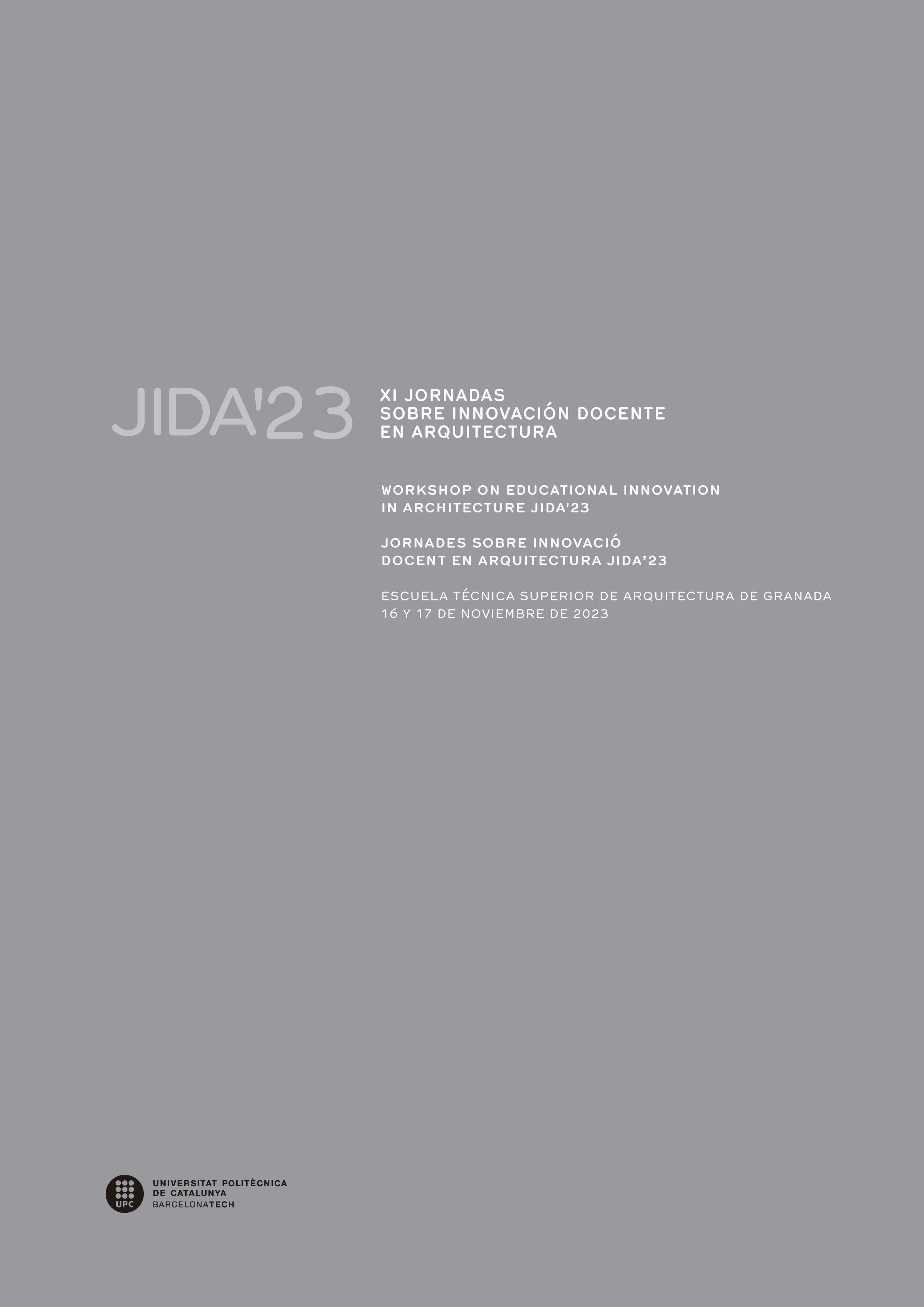Calculating the carbon footprint in design digital tools: reflections on teaching experiences
DOI:
https://doi.org/10.5821/jida.2023.12371Keywords:
Project-based learning, Life Cycle Assessment, Carbon FootprintAbstract
This teaching experience works on collective housing projects developed by the students, in which a process of evaluation of the carbon footprint is developed using digital tools and identification of possible improvements for the results obtained. This exercise involves the integration of the calculation of the carbon footprint using the Life Cycle Assessment (LCA) methodology, as well as the awareness of the impacts generated by the different systems, elements and materials that make up the building. The aim of this is to stimulate a physical and tangible approach to the calculation of the carbon footprint incorporated into the architectural design, where the implications of the design, the volumetry of the building, the importance of optimisation in the design of the different systems that make up the building, as well as the selection of materials can be identified.
References
Portal Oficial de BIM Forum. <https://bimforum.org/> [Consulta: 15 de septiembre de 2023].
Portal Oficial de Level(s). <https://environment.ec.europa.eu/topics/circular-economy/levels_en> [Consulta: 15 de septiembre de 2023].
CEN EN. 2011. Sustainability of construction works - Assessment of environmental performance of buildings - Calculation method. EN 15978:2011. Bruselas: CEN.
Portal oficial de Herramienta VERDE de GBCe. <http://www.gbce.es/pagina/certificacion-verde> [Consulta: 15 de septiembre de 2023].
Parlamento Europeo. Amendments 14/03/2023 for Energy Performance of Buildings Directive (recast). <https://www.europarl.europa.eu/doceo/document/TA-9-2023-0068_EN.html#title1> [Consulta: 15 de septiembre de 2023].
Comisión Europea. The European Green Deal. <https://doi.org/10.1017/CBO9781107415324.004> [Consulta: 15 de septiembre de 2023].
Portal oficial de Klimatdeklaration för byggnader. < https://www.nj.se/offentligapublikationer> [Consulta: 15 de septiembre de 2023].
Portal oficial de INDICATE project . . [Consulta: 15 de septiembre de 2023].
Portal oficial de IEA EBC ANNEX 72. <http://www.iea-ebc.org/projects/ongoing-projects/ebc-annex-72/> [Consulta: 15 de septiembre de 2023].
International Energy Agency. Global status report for buildings and construction 2019. <http://doi.org/10.1038/s41370-017-0014-9> [Consulta: 15 de septiembre de 2023].
ISO. 2013. Greenhouse gases - Carbon footprint of products - Requirements and guidelines for quantification and communication. ISO 14067:2013. Ginebra: ISO.
Portal oficial de MilieuPrestatie Gebouwen - MPG. <https://www.rvo.nl/onderwerpen/wetten-en-regels-gebouwen/milieuprestatie-gebouwen-mpg> [Consulta: 15 de septiembre de 2023].
Portal oficial de Tally-Autodesk. <http://choosetally.com/> [Consulta: 15 de septiembre de 2023].
Meex, E., Hollberg, A., Knapen, E., Hildebrand, L., & Verbeeck, G. 2018. "Requirements for applying LCA-based environmental impact assessment tools in the early stages of building design" en Building and Environment, 133, 228-236. <https://doi.org/10.1016/j.buildenv.2018.02.016> [Consulta: 15 de septiembre de 2023].
Jefatura del Estado. Gobierno de España. Ministerio para la Transición Ecológica y el Reto Demográfico. 2020. Ley 7/2021, de 20 de mayo, de Cambio Climático y Transición Energética. (BOE núm. 121, de 21 de mayo de 2021) 62009-62052.
Ministerio para la Transición Ecológica y el Reto Demográfico. 2020. Estrategia de descarbonización a largo plazo 2050. Marco Estratégico de Energía y Clima. <https://ec.europa.eu/clima/sites/lts/lts_es_es.pdf> [Consulta: 15 de septiembre de 2023].
Rizzotti, P. 2022. Housing Footprint - Light and low Carbon Construction, Paris, Pavillon de l’Arsenal.
Röck, M., & Sørensen, A. 2022. Towards embodied carbon benchmarks for buildings in Europe #2 Setting the baseline: A bottom-up approach. <https://vbn.aau.dk/en/publications/towards-embodied-carbon-benchmarks-for-buildings-in-europe-2-sett> [Consulta: 15 de septiembre de 2023].
Soust-Verdaguer, B., Bernardino Galeana, I., Llatas, C., Montes, M. V., Hoxha, E., & Passer, A. 2021. "How to conduct consistent environmental, economic, and social assessment during the building design process. A BIM-based Life Cycle Sustainability Assessment method" en Journal of Building Engineering, 45, 103516. <https://doi.org/10.1016/J.JOBE.2021.103516> [Consulta: 15 de septiembre de 2023].
Soust-Verdaguer, B., Llatas, C., & García-Martínez, A. 2017. "Critical review of BIM-based LCA method to buildings" en Energy and Buildings, 136(1), 110-120. <https://doi.org/10.1016/j.enbuild.2016.12.009> [Consulta: 15 de septiembre de 2023].
DGNB. 2019. Certificate for Sustainable and Green Building. <https://www.dgnb.de/> [Consulta: 15 de septiembre de 2023].
Naciones Unidas. 2019. The Sustainable Development Goals Report 2019. <https://unstats.un.org/sdgs/report/2019/The-Sustainable-Development-Goals-Report-2019.pdf> [Consulta: 15 de septiembre de 2023].






















